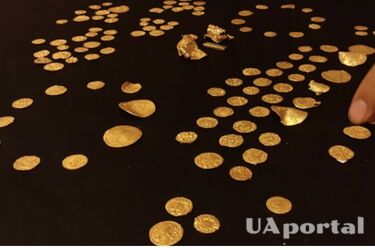Gold items dating back to 600 found in England: the largest Anglo-Saxon treasure

The British Museum has announced that the largest Anglo-Saxon treasure to date has been found in Norfolk. This hoard consists of 131 gold coins, mostly Frankish tremises, as well as nine Byzantine solids. In addition, a small gold bar and gold jewelry were found, including one complete object (apparently a pendant) and fragments of two other pieces of jewelry. The approximate date of the treasure is around 600 AD.
This was reported by Naked Science.
Interestingly, although experts at the British Museum consider these items to be a single collection, they have been looking for them for many years. As early as 1991, the first coin was found in a privately owned field. However, it was only in 2014 that the systematic search for parts of the treasure began. After six years of work, the project was completed and the treasure was handed over to specialists.
Most of the gold items were found by a single prospector who wanted to remain anonymous. But ten more coins were discovered by another person, a police officer.
In 1996, the Treasure Act was passed in Britain, according to which all objects or money over 300 years old that consist of precious metals (at least 10% of precious metals in an alloy) or are part of a single complex with objects made of precious metals are considered treasures. All found items must be presented to the coroner at the place of discovery, after which they are recognized as the property of the crown. The person who finds the treasure and reports it to the coroner first participates in a mandatory investigation and then, at best, receives a thank you note. Citizens are not very willing to share their valuables. In 2012, the law was amended, and now a citizen who finds a treasure and reports it to the coroner can receive a payment of 100% of the nominal value of the treasure. At the same time, he must transfer half of the amount to the owner of the land.
However, a policeman who found ten coins decided not to notify the coroner and sell them on the black market himself. He was caught and detained. As a result, the former law enforcement officer was allegedly dismissed from the service and sentenced to 16 months in prison, while the traces of the two coins he sold remained unknown.
Read also: Fossils of prehistoric snakes 6 thousand years old found in China (photo)
Currently, the Norfolk coroner is conducting an investigation, the results of which should finally determine which of the found items fall under the Treasure Act. For example, experts believe that a coin found in 1991 may not be one of these items, even if it is proven to be part of the same treasure. After the investigation is completed, Norwich Castle Museum plans to buy the collection with the support of the British Museum.
Gareth Williams, an employee of the British Museum, said that the find is very important. In terms of dating, it is close to the famous ship burial from Sutton Hoo in Suffolk. This is the largest coinage of that period that has been found.
As a reminder, an early Iron Age burial ground containing rare artifacts was found in Austria.
If you want to get the latest news about the war and events in Ukraine, subscribe to our Telegram channel!
